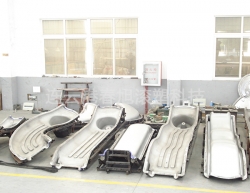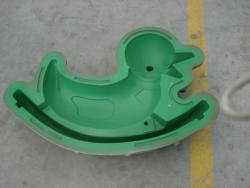Understanding rotomolding
date::2016-07-27 author: click:
Rotomolding is a fairly versatile manufacturing process. It will provide you with unlimited design space, and all you have to pay is a very low cost product.
production process
Before the rotomoulding process, you need to prepare some good molds and place them on a molding machine. This casting machine also has two devices for heating and cooling. After placement, first place a few molds on the machine. Then, early regular plastic resin was placed in each mold, and the mold was slowly rotated from the two vertical and horizontal angles into the oven. The melted resin binds the hot mold and the outer package evenly and tightly together. Subsequently, the mold is placed in the refrigeration cycle apparatus again, and the mold continues to rotate therein until the thickness of each portion thereof is uniform. After the mold has been frozen, remove it from the machine. Throughout the production process, the speed of the mold rotation, heating and cooling time all have to be strictly controlled.
Design advantages
Compared with other mould processes, rotomoulding provides us with more design space. Under the correct design concept, we can combine several parts into a complete mold, which greatly reduces the high assembly costs.
The rotomoulding program also includes a series of intrinsic design thinking methods, such as how to reconcile the sidewall thickness and how to strengthen the external settings. If you also need to add some ancillary designs, then we can also add ribs to the design.
The rotomolding process injects designers with endless imagination. Designers can choose the best materials for the production process, including materials approved by the General Directorate of Food and Drugs. Additives put into the production process can effectively resist the invasion of the climate, static electricity interference and other external factors. During the design process, inserting the mouth, threading, handles, undercutting devices, and perfect surface design are among the highlights. Designers can also design a multi-wall mold that can be either hollow or filled with foam.
Cost advantage
When cost is also one of the factors we consider, the rotational molding process has a market advantage over other types of processes. When compared with the blow molding process and the injection molding process, the rotational molding process can more easily produce parts of different sizes within an effective cost range. His mold is also relatively inexpensive, because it does not have some internal cores that need to be completed. And in the absence of an internal core, only a little change can be made into another model.
Since the components in the manufacturing process are finally formed under the high-temperature and rotating processes, unlike those formed under the heavy pressure, the rotational molds do not need to be specially processed like the injection molding process. It withstands the test of stress.
As for the production costs used to produce the conversion products, the cost has also dropped, because light plastics often require more raw materials to be converted into heavy plastics. For the rotomoulding process, the cost-saving single master model will be its future high-yield development trend.
tags:Rotationalmouldmanufacturers
Related Products:
related news:
- Rotational process characteristics
- What is rotomolding?
- Development Overview of Rotational Molding Industry in China
- Simple introduction of rotomolding
- Rotational molding technology gradually becomes a hot process
- Simple introduction to the process of rotomoulding product processing
- Rotational molding and its use in industry
- Rotary Molding Industry Development Overview
- The application of rotomolding process is bound to become the mainstream
- The future of rotomolding industry














